#Grassy Marsh
Text
19.) My first sweater made with eyelash yarn, representing a grassy marsh. Inspired by an exhibit of one at National Aquarium. And very different from any clothing anyone normally wears. #sambarsky #sambarskysweaters #sambarskyknitter #knit #knitting #knitter #art #artist #sweater #intarsia #handknit #marsh #swamp #grass #wetlands #eyelash #swampgrass #marshgrass #grassymarsh

#sambarskyknitter#sambarsky#sambarskysweaters#knitting#knit#sweater#art#knitter#artist#handknit#marsh#swamp#grassy marsh#grassymarsh
14 notes
·
View notes
Video
Exploring the Wildflowers and Hillsides of Lincoln National Forest by Mark Stevens
Via Flickr:
A setting looking to the south while taking in views across a field of wildflowers to a more distant hillside in Lincoln National Forest. This was at a roadside pullout on a graveled road heading to the Ski Cloudcroft area. In composing this image, I decided to get down low and capture a look across and then beyond this field. I decided to have the grassy meadow and hillside fill most of the image with only a little bit of skies above. I found the latter to be overcast and really didn't add much to the image or setting.
#Azimuth 181#Clouds#Clouds Above#Cloudy#Day 4#DxO PhotoLab 6 Edited#Evergreen Trees#Evergreens#Forest#Forest Landscape#Grassy Area#Grassy Field#Grassy Marsh#Grassy Meadow#Hillside of Trees#Intermountain West#Landscape#Landscape - Scenery#Lincoln National Forest#Looking South#Meadows#Mostly Cloudy#Mountain Peak#Mountains#Mountains in Distance#Mountains off in Distance#Mountainside#Nature#Nikon D850#No People
4 notes
·
View notes
Text
Tidal Marshes are an Interesting Florida Habitat to See
Tidal Marshes are an Interesting Florida Habitat to See shows viewers a typical tidal marsh. It explains the habitat and some of the things that make it unique. It also touches on a couple reasons that these areas are important to keep healthy.
Tidal Marsh
At first glance, the tidal marsh just looks like a large sea of grass, but it is actually a highly complex and incredibly interesting ecosystem. There are many, many plants and and animals that make this sea of grass their home. The tidal marshes occur where the tides come and go. They are often located at the mouths of rivers or around bays and inlets. The water in these areas is…

View On WordPress
#beautiful habitats#beautiful landscapes#brackish marshes#Florida habitats#Florida landscapes#Florida marshes#grassy marshes#habitats#interesting habitats#interesting landscapes#landscape photographs#landscape photography#landscapes#marshes#marshy landscapes#photography#tidal marsh habitat#tidal marsh landscapes#tidal marshes
1 note
·
View note
Text
The Costal Valley Territories

I made a map of the Whisper-verse clan's territories!
These clans live alongside the sea in a small valley split by a river!
Note: this map is more representative than entirely accurate, I just tried to show the basic idea of what the territories look like.
Descriptions of the Clan Territories below!
Moon Island:
Moon Island is both the gathering place for the clans on the full moon, and the place where the majority of the clans (excluding Whisperingclan) go to speak to Starclan. In the middle of the island where the trees form a circle around a large stone, the leaders will perch for meetings. This is also where cats wishing to speak to Starclan sit- under the light of the moon and stars.
...
Whisperingclan:
Age/origin: Youngest clan; formed after the founders were banished from Roaringclan for a coup against the new leader.
Territory: the tallest mountains, rocky, though with some trees, grass and bushes interspersed with the stone. There are a few small creeks and pools running through the mountains due to rain and snow run off, there are also several caves within the mountain. The winter is the worst here with the high altitude and high snowfall.
Camp: the Whispering Cave, a large cave filed with mystical glowing crystals which seem to whisper with the words of the Starclan ancestors. There are several pools above the cave, from which small streams of water fall through cracks in the stone into the cave.
Borders: the River marks the border with Roaringclan and SIngingclan; the border with Growlingclan is only marked with scent markers, though the change in territories can also be seen in the mountain peaks becoming lower and sharper in Growling territory.
...
Roaringclan:
Age/Origin: One of the oldest clans, formed at the same time as Singingclan and Echoingclan; territory was once larger, but was taken over by humans.
Territory: grassy, hilly, plains. Notable features are small patches of trees and bushes, a lake, a muddy/ soil patch by the river, and many little burrows to be found amongst the hills.
Camp: the Abandoned Burrows, a circle of empty fox burrows surrounded by trees and bushes.
Borders: the River marks the border with Whisperingclan; the creek marks the borders of Singingclan and Weepingclan; and on all other sides a human fence marks where their territory ends and the Human Farms begin.
...
Weepingclan:
Age/Origin: Second youngest, though still far older than Whisperingclan; formed from Singingclan separating into two clans, not from any all out fighting, but the realization that there were two obvious separate groups (in skill and personality) in the clan that could survive better in the separate territories.
Territory: marsh lands and dark forests made up of willows and oaks. The forests have soft thick wet peat, though there are some rocky places. Tall grasses and reeds grow around the marsh giving good cover.
Camp: The Weeping Grotto, a large cave opening within a rocky area of the forest of which is surrounded by the largest and oldest weeping willows of the territory.
Borders: the border with Roaringclan is marked by the creek; the border with Singingclan is marked by scent markers, though the change in territories can also be seen in the change in types of trees; the small piece of border with Echoingclan is separated by the river at it's widest, though both clans lay claim to half of the row of stepping stones which could connect the territories; the border which is not shared with any clan stops where human trails (hiking trails) begin, farther from there are human dens and farms.
...
Singingclan:
Age/Origin: One of the oldest clans, formed at the same time as Roaringclan and Echoingclan; originally encompassed Weepingclan as well, but they amicably separated into two clans for better survival.
Territory: forests made of oak and birch along with meadows filled with wildflowers and grasses. Through the center of the territory runs the River and a small creek shoots off through the territory as well. the river is banked by reeds and other water plants.
Camp: the River Hollow, a space surrounded by trees in the center of the island in the middle of the River within their territory.
Borders: the border with Roaringclan is marked by the creek; the border with Whispering and Growlingclan is marked by the River; the border with Weepingclan is marked by scent markers, though the change in territories can also be seen in the change of types of trees; and the border with Echoingclan is marked with scent markers, though it is easy to tell where it is, it is where the sand begins.
...
Echoingclan:
Age/Origin: One of the oldest clans, formed at the same time as Roaringclan and Singingclan; originally encompassed Growlingclan as well, though unlike Weeping and Singing, the separation was born from civil war, the losing side being Growlingclan.
Territory: a beach, almost entirely sand with only costal plants growing in the territory. There is a cliff line which is made up of rock, at the higher end of which the beach is mostly rock with tide pools, weathered stone arches, and the opening to a system of sea caves. This territory seems small, but the sea caves stretch out underneath for large expanses, and even under Growlingclan's territory, Echoingclan lays claim to all of the cave system even under other clan's terriotories.
Camp: the Sea Caves, mostly the large cavern formed at the front opening of the Sea Caves but some cats may even make their own dens in smaller off shoots of the caves as well.
Borders: most of their borders are at the sea's edge, though their borders with the other clans are marked with scent markers; it is easy to tell where territories end however. the border with Singingclan is where Singing's grass begins, and the border with Growlingclan is where the mountain's stone begins.
...
Growlingclan:
Age/Origin: Third youngest, though still far older than Whisperingclan; formed from Echoingclan separating into two clans, two factions in the clan had formed and went into a civil war, Echoing won and banished the losing side to the far less hospitable side of the territory.
Territory: Truly one of the harshest territories, the lower levels of the mountains, rocky sharp lands that end with cliffs along the sea shore that are too high to dare try to reach the sea. There are small groups of shrubs and small trees, but little else in the form of plant life. there are some small pools which are cherished as they are the only certain sources of water.
Camp: the Broken Crag, a cliff face which is broken in places revealing small caves where cats can make dens.
Borders: the border with Whisperingclan is marked with scent markers though the change in territories can also be seen through the mountain peaks becoming higher in Whispering territory; the small border with Singingclan is marked with the river; the border with Echoingclan is marked with scent markers though it is easy to tell where the border is, it is where the sand begins.
#this was fun to make#I love world building :3#whisperingclan#cryptid plays clangen#clangen#warrior cats#my ocs#warriors#ocs#singingclan#roaringclan#echoingclan#weepingclan#growlingclan#the other clans
482 notes
·
View notes
Text
Moth of the Week
Drinker
Euthrix potatoria
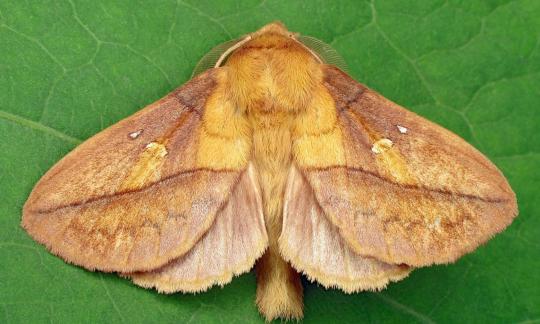
The drinker moth is of the family Lasiocampidae. It was described and named in 1758 by Carl Linneaus. Linneaus chose the species name potatoria as it means ‘drinker-like.’ Dutch entomologist Johannes Goedaert had previously called the moth dronckaerdt, meaning ‘drunkard,’ “because it is very much inclined to drinking” or because this moth repeatedly puts its head into water. The common name ‘drinker’ comes from the same reason.
Description This moth is distinguishable from other eggar moths by a diagonal line crossing the forewing and two white spots also on the forewing. Males are usually reddish or orangish-brown with yellow patches. Males in East Anglia are often yellowish. Females can be yellow, a pale buff, whitish, or a darker reddish-brown than the males. Male and females also differ in size and antennae shape: females are slight larger than males, and males have fluffier antennae.
Wingspan Range of Fully Grown Drinker: 45–65 mm (≈1.77 - 2.56 in)
Diet and Habitat The caterpillars of this species feed on grasses and reeds in genuses such as Alopecurus, Deschampsia, Dactylis, Elytrigia, Carex, Luzula, and other Gramineae. A few examples are Cat grass (Dactylis glomeratus), Common Reed (Phragmites australis), Reed Canary-grass (Phalaris arundinacea), and Wood Small-reed (Calamagrostis epigejos).
In the spring, they feed mainly at night and can be found resting on low vegetation during the day. The larva also supposedly drink morning dew because it had been observed to repeatedly put its head in water.
This moth can be found in Europe. It is common throughout England and Ireland but tends to favor western Scotland over eastern Scotland. It prefers habitats of marshy places such as fens, riversides, tall and damp grassland, marshes, damp open woodland, scrub, and ditches. However this species does sometimes live in drier habitats such as grassy terrain and urban gardens.
Mating Adults can been seen between July and August and presumably mate during this time. There is only one generation per year. Eggs are laid mainly on the stems of grasses or reeds in small clusters.
Predators Adult moths fly at night and are presumably preyed on by nocturnal predators such as bats.
Fun Fact Both sexes of the drinker moth are attracted to light, but males are especially susceptible.
(Source: Wikipedia, Butterfly Conservation)
#Euthrix potatoria#drinker#drinker moth#Lasiocampidae#libraryofmoths#facts#insects#mothoftheweek#animals#bugs#moth#lepidoptera#happy new years!#sorry for not posting
88 notes
·
View notes
Photo
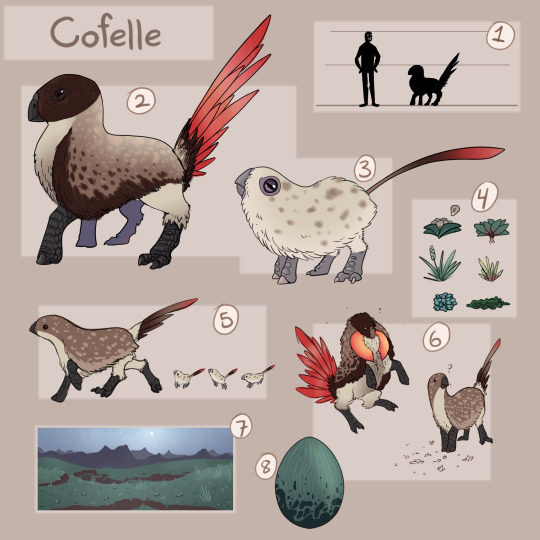
Little Mirum birdies! Want to do more in depth species pages so I’m starting with these fun guys.
1. Size chart, adult males and females are about the same size, about three feet tall at the top of their head.
2. Adult male, they’ve got shaggy furlike feathers that drape down over their elbows. Males specifically have a long fanning tail feathers and inflatable air sacks in their neck. All of these are for display, which goes in detail in section 6. Cofelle’s have a standard build of Mirum’s birds(group name still pending), but with a stockier build and a thick beak.
3. Baby. These guys come out the egg as lil white puffballs. They can run around and feed themselves from day one, but follow their mother while still small. Their down is off beige and speckled, but they have one long tail feather tipped in red.
4. The food! Their environment is full of grasses and low growing plants. They prefer eating the grain and seeds of said grasses, but will also indulge in younger, soft grasses and moss.
5. Adult female and her bouncing babies. They tend to follow behind in a straight line, just following the tail of the one in front of them. Thus they can get trapped in a spiral, which mom has to resolve.
6. Male displaying for a female. Display involves jumping up and down vigorously and making deep calls to get the ladies attention. This guy is struggling.
7. These guys live in the misty hills around Mirum’s main mountain range. It doesn’t flood here during the year and doesn’t suffer from harsh droughts. Leading to a grassy almost marsh for most of the year.
8. Eggs. They don’t have too complex nests, instead digging a shallow hole and popping the eggs in there. So they’re green to help with camouflaging when moms away to eat, otherwise they are safe underneath her.
#mirum#fantasy#worldbuilding#speculative biology#spec bio#speculative evolution#art#bird!#no true north
395 notes
·
View notes
Text
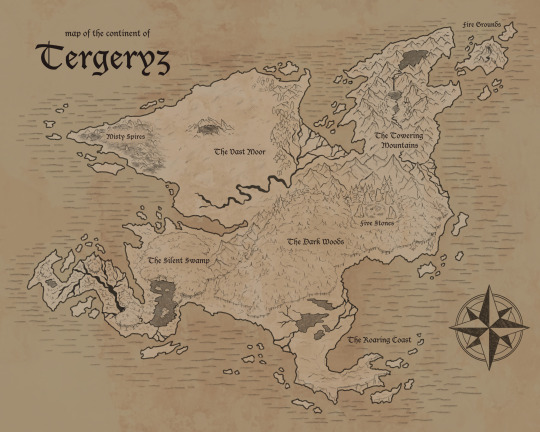
hooooly fucking hell im finally done with this thing: the AshWing continent. yay! Since kingdoms aren't a thing, the names here are used for both the territories themselves and the quivers which inhabit them. some brief explanations and descriptions of what those names mean:
Fire Grounds: a group of small islands surrounding a big one, lots of volcanic activity in here. its only inhabitants are some species of hardy wyverns such as fire dancers, and smaller fauna living on the borders where some vegetation can grow
The Towering Mountains: massive mountain ranges surround a valley where mountain gliders and wreckers reside. minerals from extinct volcanoes made the soil incredibly fertile, and the natural barriers protect against most predators, making this place a safe paradise
Five Stones: a mysterious monument, consisting of five huge rock monoliths jutting out of the ground, with writing carved into the stone describing the history of FrostWings and AshWings alike. Meetings and festivals involving all quivers take place here, and any damage done to the stones –accidentally or not– strangely disappears by morning. dragons that have been there describe the place as having a soothing yet uplifting aura
The Dark Woods: an immense, dense forest with giant trees and plenty of resources make this the perfect home for wood walkers. unfortunately, scavengers also like making settlements here, so run-ins with dragons aren't uncommon
The Vast Moor: seemingly never ending grassy plains are the main scenery of this region, but a wide sinkhole interrupts this perfect flatland. moor runners have dug deeper into it and reinforced the cave walls, sheltering them from the outside and weather. an aquifer at the bottom provides plenty of water, and it is believed underwater cave systems connect it to other parts of the continent
Misty Spires: small canyons and tall rock formations shrouded in mist and surrounded by howling winds make up this small portion of moor runner territory. few dragons ever go there though, as rumor has it it is haunted. when the fog comes down into the main territory, going out into the fields is not advised
The Roaring Coast: home of the fierce coast strikers, only quiver in the continent that dares venture into the sea. leviathans and sea serpents infest these waters, so dragons here aren't always the apex predators. houses are carved out of the cliff face. a gigantic sea monster skeleton goes on along the coast, with leaders making its skull their main living place
The Silent Swamp: danger is a constant, so being always on the lookout is a must if one is to survive here. giant serpents and crocodiles inhabit the waters, wyverns patrol the skies, scavengers travel along marshes and rivers, and noxious poisons are something that many creatures share here, both predator and prey. however, this harsh environment doesn't deter swamp lurkers from making the most out of these murky waters and shady forests

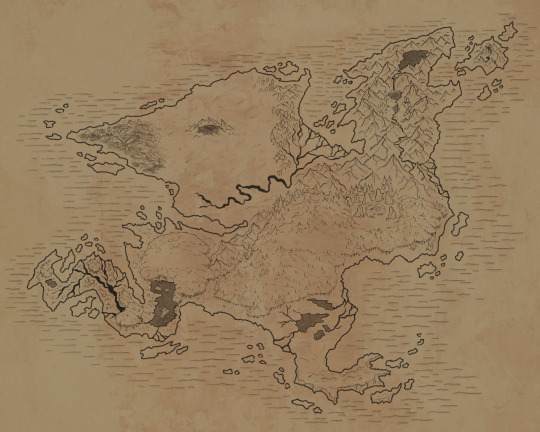

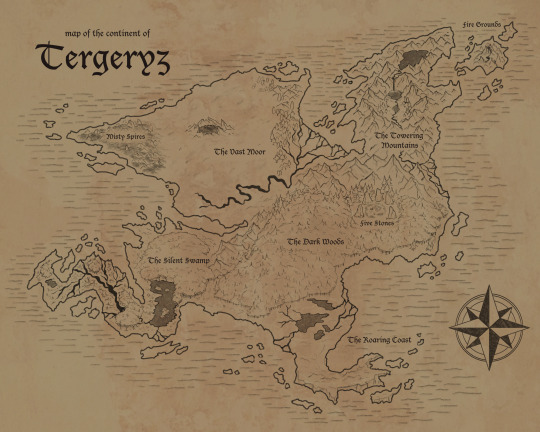
Plus some extra versions teehee (uploading them the first time crashed my whole laptop :p) oh and paper textures are from unsplash
#wof#wings of fire#ashwing#GOD DAMNNNNN i was having fun intil i had to do the forests jfc#yes that sea monster skeleton thing IS inspired by the lost river in Subnautica bc it goes hard as fuck#btw think of the swamp as a mix between the poison jungle and the mud kingdom#btw i have wof and tf drawings planned so worry not!#also in the swamp there's meant to he like most of it covered in trees vegetation and water but it would've obscured the outline#pretend it's there lol
132 notes
·
View notes
Text
Primamorphs
This is an incredibly diverse Euconch group, with far more genera than I can possibly categorize currently, so I will focus on the more commonly seen species. They all share the same relatively primitive traits. They have fewer bones than other Mollichordates; their limbs contain small, rod-like bones connected by muscles and ligaments. This allows greater flexibility, but prevents them from getting very large. Unlike other Mollichordates, they only have one or two toes per foot.
BarkLumps:
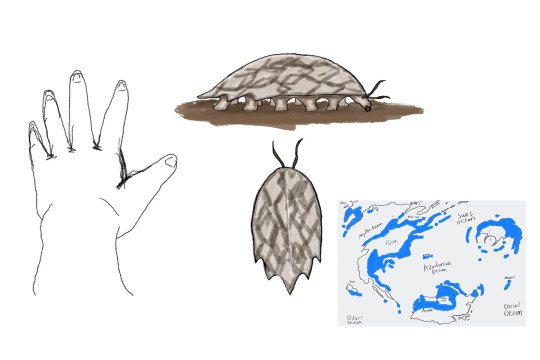
Pictured: the titan BarkLump, found in the forests of Maari.
These diminutive animals live worldwide, anywhere that there are decaying logs. With rasping mouthparts and ten little feet lined with suction cups, these creatures cling to dead trees and slowly scrape away rotting matter, feeding on the chitinous shells and the soft plant flesh within. There are hundreds of known species and potentially thousands of cryptic species waiting to be discovered with DNA testing. The species pictured here is among the largest BarkLump, nearly the size of a human hand, but most species are much smaller. The pattern on their shells mimic the trees that they prefer; this one is patterned to resemble the overlapping chitinous scales of Titanica trees.
Sapsuckers:
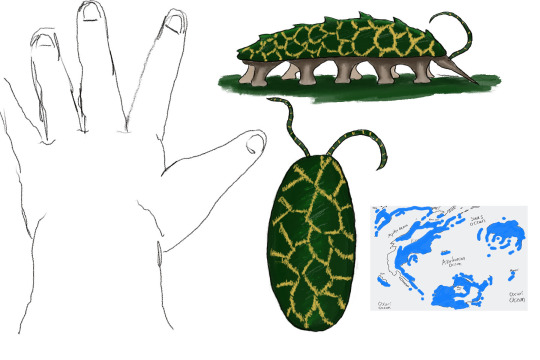
Pictured: The reticulated sapsucker, native to the labyrinth forests of Faon, is one of the larger species.
Similar to their cousins the BarkLumps, Sapsuckers are small animals that live their lives clinging to plants with the help of their many suction cup feet. But while BarkLumps eat decaying trees, Sapsuckers parasitise live plants. With the help of a highly modified beak, they insert their pharyngeal jaws into the vein of a plant and lap up the vascular fluids. Typically, the plant is unharmed by this annoying companion, but blooms of these little animals can kill even the giant Titanica trees. While many are roughly the size of the species pictured above, Sapsuckers that can easily fit on a fingernail can be found living in grassy plains and Limia carpets.
Leafies:

Pictured: the palm leaf mimic, an arboreal species living in the lush canopy of Ejoa rainforests.
Named for their incredible mimicry, these omnivores have their greatest diversity in tropical forests, but a few species can be found living in more temperate areas as well. Species which live in drier climates have shells that mimic the fat, water-filled leaves of arid plants, and species that live on the ground resemble dead leaves. They spend most of their time swaying gently with the wind, waiting for small Hexapods, BarkLumps, or Sapsuckers to venture too close and be grasped in their tiny clawed hands. They also feed on fruits, nectar, and even occasionally leaves.
Scuttlers:

Pictured: the wooly Scuttler, found in the tundra of Amki.
These elusive animals are more frequently heard than seen, scuttling around in leaf litter or the tangled roots of savannas. Eating essentially anything they come across from animals to plants to decaying matter, these are like the little vacuum cleaners of the forest floors. They are a keystone of the ecosystems, providing food for many other species and cleaning up their habitats. They are found basically everywhere except extremely arid deserts and mountaintops.
Marsh Eyes:
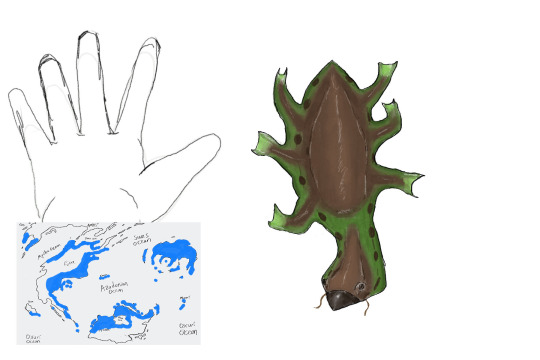
Pictured: the spotted lumpfrog, native to the Three Lakes region of Ejoa.
Semi-aquatic and skittish, these creatures live in ponds and swamps around the world. Their bulging eyes positioned on the tops of their heads are frequently the only thing you see of them before they vanish beneath the water. With webbed feet and thin, slimy skin, they are almost like an alien frog. Unlike frogs, they feed primarily on marsh plants, with occasional Hexapods and tubies as a protein source. Their shells are highly reduced to allow more agility underwater, but it can still be seen as a hard lump just under the skin.
Land Flounders:

Pictured: the Hyranese pancake, an average-sized land flounder from the deserts of Hyra.
Just like their aquatic namesake, land flounders bury themselves just beneath the sand of desert regions with only their eyes sticking out. There, they wait until something small enough to fit in their mouth wanders into reach. Their pharyngeal jaws are highly extendable, able to shoot out nearly twice their body length, and coated with a sticky mucus almost like a chameleon tongue. After a big meal, they can go months without needing to feed again.
48 notes
·
View notes
Note
naff! now that cryptid sightings is finished, could we possibly get a breakdown on which cryptid is a reference to which canon character? some are obvious, like the glamrocks, but i couldn't for the life of me figure out some of the ones mentioned in chapter 20!
i also just wanted to say what a wonderful journey it's been getting to read cryptid sightings as it was being written! i've gushed about it to literally all of my friends who will listen asdfghjkl it's hands down one of my top DCA fics ever <3
A century ago, Maetwos cornered him in the catacombs of a large city. There were many little bones. She had stalked him for days. He slipped away, much to her chagrin. She did not shake the failure for a decade.
Roxanne
In the swampy marshes of a new settlement, Adilyat encountered the cryptid with a child in his jaws. He bellowed and lunged. They both were nearly destroyed and gravely injured. Adilyat still regrets not finishing the cryptid or dying in the attempt.
Monty
During a gathering three centuries ago in a grassy land on the edge of civilization, there were terrible suspicions of Gahhar breaking the sacred rules. Children were haunted by a rabbit-like entity. All of the sacred rule holders feared one of their one was falling away but Gahhar proved his innocence.
Bonnie
Half a century back, Kakeeko told of her sorrows in failing to protect a little one. It was along a beach, the water salty. She saw the demonic cryptid, violet and cruel, jump into the water. She couldn’t swim fast enough to the child floating along the surface, her feathers soaked and heavy. She can’t bear reminders of blood in the water.
Chica
Eight years ago, Felzil was desperate to keep a child safe within his stomach cavity. A cryptid attacked him in the quiet woods. Felzil lost the child. He has been mourning ever since.
Freddy
Paahlott crossed paths with him five decades again. It was at a family restaurant. She took a puppet for her vessel to watch over the many little ones. He was there. He stole children away, possessing a golden rabbit suit.
The Puppet
That makes me so happy to hear that, ahhh! Thank you for reading, babe! ♥
52 notes
·
View notes
Note
are there words for marsh, bat and snake yet?
For bats, there's a whole bunch in the lexicon! Clan cats consider them Songbirds, with their sensitive hearing naturally picking up the sonorous melodies that our human ears cannot. They are never taken as prey.
Here's a really big intro to "Birds" in Clanmew, a cultural classification that includes bats
For Snakes, there are three types of "snakes" they encounter, one of which is cladistically NOT a snake but they do not know what science is. Snakes are part of a larger classification that includes worms.
Worm (Generic) = Pusa
A long animal without legs, which typically moves through slithering and does not "pupate" into another form. Includes earthworms, leeches, intestinal parasites, and lampreys.
Serpent (Generic) = Sis
Includes adders, grass snakes, and slowworms. A long, "scaled" worm.
Adder (Vipera berus) = Sipya
From Serpent + Slab. The man, the myth, the legend, the ONLY venomous snake that they encounter! Known for their sunning behavior, adders are typically seen in the rockiest parts of ThunderClan and WindClan, but rarely in other territories. Their bites are notoriously deadly, but they're quite shy and won't attack unless provoked.
Grass Snake (Natrix helvetica) = Washsi
From Shadow + Serpent. The most common snake in the territories, and most often seen in wetlands! Typically the word being used in RiverClan and ShadowClan prefixes, Washsi are notoriously 'showy.' Always trying to scare Clan cats into thinking they're dangerous, and playing dead if pushed too far. They primarily eat amphibians. This is the only snake that lays eggs here!
Slowworm (Anguis fragilis) = Mlemsi
From Pathetic + Serpent. A Mlemsi's best defense mechanism is dropping its tail if pulled. It's considered a snake that's being doomed to some kind of religious punishment from StarClan. THIS is the word that's typically being used as a snake-related insult, this serpent's life is a cosmic joke to Clan cats. Though this animal is technically a legless lizard, if you tried to explain that to Clan cats, they would probably laugh and think that's probably why it's the most pathetic snake and ignore you completely.
And while I'm at it: Pathetic = Mlemwia
And for marsh, there are actually three terms here.
Wetland = Felpf
This is everything that involves "marshy" terrain. Swamp, marsh, floodplain, bog, so on. You may think that these are all synonyms, but you are MISTAKEN. GOO FACTS TIME
Swamp = Kolpf
A swamp is a WOODED WETLAND. It is a nutrient-rich part of the wetland where water-tolerant trees, such as birches and willows, provide shade for lichens. Marvelous.
Marsh = Wapf
A marsh is a GRASSY WETLAND. It is an area that's too wet for anything but extremely water-resistant plants, like marshgrasses, to thrive. Sphagnum moss's natural habitat. Also marvelous.
44 notes
·
View notes
Text
Orchids of Doriath
I love doing general flora and fauna posts but I can’t fit everything in them so I’m trying to make more specific ones as well! please please feel free to send categories to work on with locations! Or any environmental world building asks!
Note that while I have many specific headcanons about the environment of Doriath, I’m always happy to take suggestions or write environment posts based on specific places (like I did with the Havens based on Southwest Australia)
Ferns of Doriath, Mosses of Doriath, Flowers of the March of Maedhros
Orchids are beloved and unique family of flowers due to their wide range of species, fascinating ecology (many grow exclusively upon other plants and obtain moisture from them, some are even parasitic, etc) and beautiful appearance. They grow throughout the world in tropical, subtropical and temperate climates
In the real world, they hold significance in many cultures, sometimes signifying elegance, growth, beauty, or in rare cases, meanings related to the parasitism of some species.
In Doriath, orchid species grow in all parts of the kingdom, in all forests. They also grow both in and around Menengroth with several species brought and cultivated by Melian herself.
Here are my thoughts for a collection of species inspiration for Doriath
and, like my post on ferns, I am going to add some world building notes at the end so it's not just listing species
Region:
Many orchids prefer calcareous soil (I’ve written before about how Region with its Holly trees and caves likely has high alkaline) so many species of orchids grow in Region
The green winged orchid grows in grassy knolls around the alkaline soil of Menengroth. The early spider orchid grows on the banks of Esgalduin near the entrances to Menengroth along with green flowered helloborine and dark red helloborine.
Lady slippers orchid grows in the more open spaces as well as the greater butterfly orchid.
Heath spotted orchids grow by streams.
The early purple orchid grows mostly in Region and Neldoreth. The lizard orchard is found in Region and Nivrim in more open areas
Neldoreth
White helloborine grows primarily in Neldoreth but can be found around Menengroth in Region too. It prefers beech forests. Red helloborine grows only in the drier parts of Neldoreth and green flowered helloborine grows in Neldoreth and Nivrim.
Three toothed orchids grow in Neldoreth and occasionally in Nivrim
Bird’s nest orchids also favor beechwoods and so grow in Neldoreth
Lesser butterfly orchids grow primarily in Neldoreth but occasionally grow in Region too.
Nivrim:
White egret flowers can be found in the marshes south of Nivrim
Sword leaved helliborine lives in swampy forests and so grows throughout Nivrim. Violet birds nest orchid grows in Nivrim as does lizard orchid
Yellow bee orchids live in the drier areas of Nivrim along with Epipactis tremolsii.
Nivrim, Region and Neldoreth
Pale orchids grow in open spaces and by the waters
Common twayblade grow in drier areas
Arthórien:
( I headcanon that Arthórien has a markedly different climate than the rest of Doriath for a number of reasons: the cultivation and practices of the green elves who live there, slightly different elevation (based largely on my own speculation), the rivers, and some intervention by Melian. )
Aerides lawrenceae grows in the forests here as does Acampe rigida
Common Christmas orchid, blood stained dendrobium
Marsh helloborine, soldier orchids and fairy orchids grow by the waters and winter orchids grow in more open spaces.
Creeping forest orchids grow here and occasionally over the river in Neldoreth.
All:
Ghost orchids grow sparsely throughout Doriath . Musk orchids more commonly so as do species of wide lip orchids
Bog orchids grow by the rivers and in marshier areas of all four forests
Significance to the Sindar and Nandor of Doriath:
It's interesting to note that no word for orchid appears in any of Tolkien's languages. I was surprised to find this as they are such a wide and varied family of flowers and he was so interested in botany! So any of the notes on language here are my own headcanon. I have not yet come up with a word for them in Sindarin yet (I probably won't be able to do Nandorin as our knowledge of it is much more limited) but I will try to!
Orchids are beloved by the elves of Doriath. A number of species grow within the sacred gardens of Menengroth and others are specially cultivated by the servants of Melian. Species like bee orchids are only found in the gardens of Menengroth and the servants and students of Melian often experiment with their pollination and cultivation, sometimes creating new varieties.
Orchids in the Sindarin language and knowledge are distinguished by their unique petals and stems and asymmetrical bodies as well as their behavior and pollination patterns. Their growth is sometimes associated with places of magic and twilight
Though the flowers themselves are not disliked by the Silvan elves, some of their number in Doriath associate the natural growth of orchids with places of tragedy. They are also associated with transitional ecosystems and with shadier parts of the woods.
As always please feel free to ask more. I love talking about ecology stuff and the relationship of people and elves to the natural world
57 notes
·
View notes
Video
High Mountain Adventures in Lincoln National Forest by Mark Stevens
Via Flickr:
While at the Trestle Vista Observation Site in Lincoln National Forest with a view looking to the southeast to some nearby wildflowers and then the Mexican Canyon Trestle.
#Azimuth 146#Bridge#Cloudy#Day 4#DxO PhotoLab 6 Edited#Evergreen Trees#Evergreens#Forest#Forest Landscape#Grassy Area#Grassy Field#Grassy Marsh#Grassy Meadow#Hillside of Trees#Intermountain West#Landscape#Landscape - Scenery#Lincoln National Forest#Looking SE#Meadows#Mexican Canyon Railroad Trestle#Mexican Canyon Trestle#Mostly Cloudy#Mountainside#Nature#Nikon D850#No People#Outside#Overcast#Partly Cloudy
2 notes
·
View notes
Text
More sub biomes and a further updated map!
Here are some sub biomes from the forest and swampland biomes!
Redwood forests
Huge forests of giant redwood trees, where plants like ferns and berry bushes, and ivy are common. This is the biome that Eldur city once resided in.
Swamp wastelands
A swampy muddy area with very few large trees, most foliage remains close to the ground and is often decaying as mushroom growth is common here.
Myco island
An island where a majority of life is made up of mushrooms! Large ones resembling trees, as well as few trees themselves! Though any true tree in this island has been taken over by the mushrooms and mycelium
Grand oak forest
Grand oak forests are somewhat similar to the standard oak forest, except the trees here are meters thick, often growing non-functional faces in the centre of their trunks. Albino animals are common here, as predators are sparse.
Myco forests
Myco forests are a sub biome of the Myco island, Myco forests used to be lush forests before the spores of Myco island spread through the woods. Now the trees are barren and covered ins many species of mushrooms.
Lush taiga
Lush tiara is are a transitional sun biome between the polar forests and standard forests. They are full of tall thick pine trees, covered in moss and mushrooms.
Forested swamps
Forested swamps lie between the swamp safe lands and forests. This sub biome is full of many small streams, abundant with lily pads, moss, and vines, thin small trees make up the forest of these forested swamps.
Willow swamps
Lush swamps lined with weeping Willow trees, small streams and lakes filled with algae and duckweeds, an abundant sub biome where the sun shines brightly through the leaves.
Grassy marshes
The grassy marshes are patches of grasses both tall and short, growing within shallow waters .
———————————————————
And again if you ever want to add your ideas to this fantasy world you are always welcome to submit them! Either through dms or ask box or even just a post of your own (but tag me so I can reblog it :))!
Prompts and updated map below the cut!
Prompts:
What would a mountainous sub-biome look like?
Would there be any sub biomes where the people of Kenalia don’t enjoy being in/refuse to stay in?
What landmarks or civilization would you find in the lush taiga?
What kind of creatures live on Myco island?
Why is it common for the grand oak trees to grow faces?
And here’s the updated map!!

11 notes
·
View notes
Text
Camp Krell - chapter one, part one
Run.
The single syllable screamed silently in my thoughts, as the forest path drew ever closer. I didn’t dare look back, I could hear its soft footsteps closing in on me, not catching up, just keeping in pace. Like it was taunting me. Toying with me. Treating my life as another plaything in its twisted little toy box that was the Krellden woods. My footfalls thudded, then squelched, as the ground I was dashing across shifted from grassy underbrush to boggy marsh.
I had to reach the path, it was light, it was familiar, it was safe. The path would get me back to camp, back to bed, back to my friends, back to… Elaine. The reason I was running. Back to her. The sole reason I was in this mess, sprinting for my life like a mad rabbit stalked by a fox. I should’ve never agreed to this dare, but if not me, then who? Who would’ve been her next victim? Who would she have sent into this creature’s den next? It didn’t matter. All that mattered was that I kept running.
The path was right there, I was so close! Until I tripped. A tug at my feet. My laces had snagged on a branch stuck in the marsh, and I stumbled, falling face first into the marsh. I tried to tug myself free, but both my arms and legs were now stuck in the boggy earth, and I was sinking. The footsteps still drew ever closer, but… they had slowed. Whatever this creature was that was chasing me, it was either taking its sweet time in letting me drown in the mud before it ate me, or it truly was just chasing me for the thrill of the hunt. Reassuring, huh? I tried to pull back up, but my arms were already submerged up to my elbows and I started to panic, frantically trying to find some purchase
of solid ground to push myself up and resume my running back to the safety of camp.
Thats when I felt it. A clawed hand, gripping me by the neck, pulling me out of the mud. Yet, for something that I assumed to be chasing me for the kill, it was surprisingly gentle when it lifted me from the marsh, setting me softly on a log. Its fingers felt soft, not like fur, but like the scales of a snake, memories of my grandmother’s ball python Monty replaying in my mind. Was this what all those authors meant by your life flashing before your eyes...? It’s hand - if you could even call it that - coiled around my throat as it placed me on my feet. And I heard it. ‘Keep running’, it cried, ‘Keep running. You’ve made it so far, keep running. I’m not done playing with you yet.’ But as it spoke, its voice was never resonated by the echoey surroundings of the forest, it played distorted and warped directly in my ears, the voice sounding… oddly familiar, yet so foreign at the same time.
So I ran.
7 notes
·
View notes
Text
“endless” and “return” from this prompts list, requested by @mercurygray ‘for your newest-to-you fandom!’
Okay, so we all said we wouldn’t come up with OCs for MotA before the show even came out, but, well. Meet Rosie Clifton, ATA pilot, who strolled into my head before I could tell her to wait her turn.
Twice a week she is put on taxi duty, flying the Anson from airfield to airfield to ferry the pilots to their next delivery. In the bluish half-light of dawn she taxies out and takes off, feeling the familiar and still-thrilling swoop in her stomach as the machine finally lifts into the air. She is kept busy through the day, and in the evening she makes the rounds again, picking up the pilots close enough to the pool to bring back; the others are fated for an overnight stay somewhere, or a nighttime journey by rail, sitting on their flight bags in the corridor of a cramped and stuffy train.
It is the end of a glorious day in late summer. This is the time she loves the most, the image to hold on to in the depths of winter, shivering in some draughty dispersal hut: the sun slipping beneath the clouds and gilding their edges, the sea still, today, and shining like beaten copper, the fields and waterways of the Fens and Broads stretching out beneath her, seemingly endless, disappearing into the golden haze along the horizon. Trees and churches and windpumps cast long shadows; she catches sight of the shadow of the Anson, too, rippling across salt marsh and grassy farmland, across rivers and woods.
Behind her, along the length of the fuselage, her passengers are shouting to each other, trying to make conversation over the roar of the engines. Rosie is quite content in her solitude. She could fly on and on like this, chasing the lowering sun forever westwards.
She follows the curve of the coast, flying low, glimpsing a train, billowing steam, cars on the roads, the white sails of small boats on the rivers. The sun glints off something in the far distance: barrage balloons around London. She crosses the Deben, the Orwell, the Stour, and turns the aeroplane inland, skirting the smoke over the city.
They return home by following the edge of the Chilterns, and Rosie lands back at White Waltham in the gathering dusk almost in a daze, her legs adjusting to the ordinariness of walking and her head still in the clouds, sunlit and perfect.
#If there's one thing you should know about me it's that I'm going to describe a sunset#Thanks Merc! It was good to get something down for Rosie#OC: Rosie Clifton#My writing
9 notes
·
View notes
Text

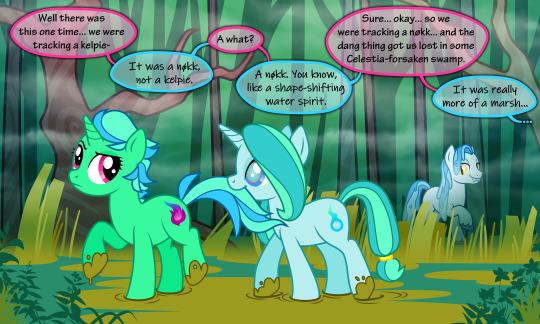
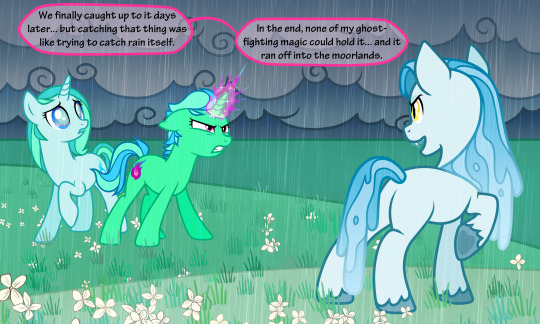

Ghostfire: I don't know if it counts as a rival, but that was one slippery nøkk.
Spirit Light: It wasn't any wonder your magic didn't work on it. It wasn't a ghost. It was a spirit, but not the right kind of spirit for us to handle.
Ghostfire: Pffsh. I can handle some dumb swamp-walker. Next time I see that nøkk, I'll have my iron horseshoes ready.
Spirit Light: Still... I wish I knew where those sheep vanished to...
Image ID Below the cut
Image 1: Two screenshots of asks from Drive and an anonymous sender.
Drive: were/are there any particular bad spirits that escaped you often or you deal with regularly that is sort of like a nemesis or something? Or any particular friendly spirits you encounter often?
Anonymous: Have you ever run into fey? I imagine they get reported as spirits sometimes mistakenly... how do you/would you solve them?
A speech bubble outlined in fuchsia denotes Ghostfire speaking from offscreen.
Ghostfire: Okay, yeah. I got one.
Image 2: Ghostfire, a green unicorn with a blue mane, leads her sister Spirit Light, a pale blue unicorn with a teal mane, through a dark swamp. Spirit Light has pale blue, blind eyes, and is holding onto her sister's tail for guidance. In the background, a light blue pony with a mane and tale made of water stands, watching the sisters and grinning with sharp teeth. Speech bubbles outlined in fuchsia denote Ghostfire's voice, while speech bubbles outlined in blue denote Spirit Light's.
Ghostfire: Well there was this one time... we were tracking a kelpie-
Spirit Light: It was a nøkk, not a kelpie.
Ghostfire: A what?
Spirit Light: A nøkk. You know, like a shape-shifting water spirit.
Ghostfire: Sure... okay... so we were tracking a nøkk... and the dang thing got us lost in some Celestia-forsaken swamp.
Spirit Light: It was really more of a marsh...
Image 3: Ghostfire and Spirit Light stand on a grassy hill dotted with white flowers. Spirit light is shying away with a worried look while Ghostfire is in a fighting stance, magic glowing brightly from her horn. In the foreground, a pale blue pony with a mane and tale made of water is poised in opposition, one hoof raised with a menacing sneer. The sky is dark with rolling clouds and rain is pouring down on the ponies.
Ghostfire: We finally caught up to it days later... but catching that thing was like trying to catch rain itself.
Ghostfire: In the end, none of my ghost-fighting magic could hold it... and it ran off into the moorlands.
Image 4: Ghostfire and Spirit light sit in front of a dark blue background. Spirit light look anxious and a bit sad, while Ghostfire is wearing an embarrassed grimace with one hoof raised awkwardly.
Spirit Light: We never did find those sheep... not even as ghosts.
Ghostfire: Oh. Yeah... Those sheep were super gone.
End Image ID.
#mlp ask blog#mlp#mlp oc#pony ask blog#ask blog#mlp:fim#ghostfire and spirit light#ghostfire#spirit light#ask specter sisters#ghost#fae#fae folk#kelpie#nøkk#nøkken
32 notes
·
View notes
